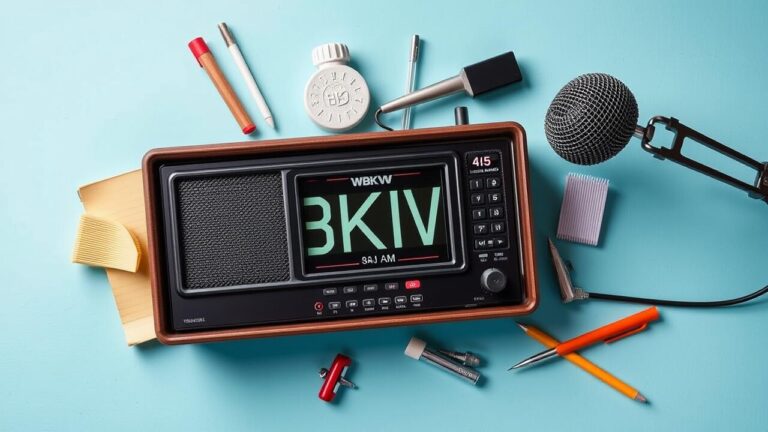What Changes Shaped the Evolution of WBKV AM
Table Of Contents
What Changes Shaped the Evolution of WBKV AM Throughout History
Key Takeaways
- Historical developments influenced the transformation of WBKV AM.
- Innovations in technology affected the operations of WBKV AM.
- Adjustments in programming occurred throughout the years.
- Legislative modifications impacted WBKV AM’s functioning.
- Rivalry dynamics and market patterns shaped WBKV AM’s strategy.
- Engagement and outreach initiatives by WBKV AM benefited the community.
What Changes Shaped The Evolution Of WBKV AM | Historical Overview of WBKV AM
The early years of WBKV AM were marked by significant developments that laid the foundation for its evolution. The station navigated the changing landscape of radio broadcasting alongside competitors like WBEL, WBCS, and WBEV. Each of these stations influenced the strategies adopted by WBKV, as it sought to attract and retain listeners amidst growing competition. What changes shaped the evolution of WBKV AM involved not only the programming shifts that occurred over the decades, but also the technological advancements that were being introduced. Understanding this historical overview illuminates the dynamics that have defined WBKV AM’s journey in the radio industry.
What Changes Shaped the Evolution of WBKV AM | The Early Years of WBKV AM
The early years of WBKV AM were marked by significant developments that would lay the groundwork for future growth. With competition from stations like WBOO, WBAY, and WBQQ, WBKV AM sought to establish a unique identity in the local broadcasting landscape. These formative years saw the station experimenting with various formats and programming decisions, striving to attract listeners and create a loyal audience. This environment of competition prompted the station to adapt quickly and embrace innovative practices.
Local audiences played a crucial role in shaping the station’s direction during this period. Community feedback influenced formatting choices while programming decisions were often tailored to meet listener preferences. The rise of WHBB as a rival introduced further challenges, yet WBKV AM continued to evolve, drawing inspiration from successful tactics employed by its competitors. Understanding these dynamics is essential for analyzing what changes shaped the evolution of WBKV AM.
Key Milestones in Development
The establishment of WBKV AM marked a significant moment in local broadcasting history. This station emerged in a competitive environment, especially with the presence of other regional players like WMVP, WGLB, KFIZ, and WLZR. Such competition catalyzed a series of strategic decisions that would ultimately influence the station’s growth and programming approach. What Changes Shaped the Evolution of WBKV AM during these formative years set the trajectory for its future relevance in the local media landscape.
As the years progressed, WBKV AM celebrated key developments that solidified its standing in the community. The introduction of diverse programming options, including local news and specialty shows, enhanced listener engagement. These initiatives were pivotal in distinguishing WBKV AM from other stations like WMVP and KFIZ. What Changes Shaped the Evolution of WBKV AM was not just about technological advancements but also about how the station connected with its audience through meaningful content.
Technological Advancements Impacting WBKV AM
The evolution of WBKV AM has been significantly influenced by rapid technological advancements. The transition from analog to digital broadcasting marked a pivotal change, enhancing audio quality and increasing accessibility for listeners. Stations like wjok, wlkd, wklj, and wnov have also adapted to these innovations, showcasing how What Changes Shaped the Evolution of WBKV AM aligns with broader industry trends. The introduction of internet streaming broadened the reach of WBKV AM, allowing for real-time interaction and engagement with a global audience. Such changes have not only transformed the station’s operational model but have also redefined the listening experience, setting new standards in the broadcasting landscape.
| Technological Advancement | Impact on WBKV AM | Year Introduced |
|---|---|---|
| Analog to Digital Broadcasting | Improved audio quality and reliability | 2000 |
| Internet Streaming | Expanded audience reach and interaction | 2010 |
| Mobile Applications | Enhanced accessibility for listeners on-the-go | 2015 |
| Podcasting | Diversified content offerings and audience engagement | 2018 |
| Social Media Integration | Increased listener interaction and community building | 2021 |
Transition from Analog to Digital Broadcasting
The shift from analog to digital broadcasting marked a significant turning point in the evolution of WBKV AM. This transition allowed the station to enhance sound quality and provide stereo broadcasting, similar to its competitors like WSAU, WIZM, and WIBD. Listeners began to enjoy a richer audio experience that improved overall engagement and satisfaction.
Embracing digital technology also enabled WBKV AM to innovate its programming and reach a broader audience. The enhanced capabilities opened up new opportunities for interactive broadcasts and real-time listener feedback. These changes played an essential role in shaping the station’s identity and adapting to the demands of modern radio, aligning with what changes shaped the evolution of WBKV AM.
Adoption of Internet Streaming
The introduction of internet streaming marked a pivotal moment in the evolution of WBKV AM. This change allowed listeners to access programming beyond traditional radio signals. Competing stations like WLBL and WCLB began to embrace streaming technology, enhancing their reach and accessibility. The ability to stream live content expanded WBKV AM’s audience demographics, drawing listeners from locations far removed from its geographical broadcast range.
The landscape of radio consumption transformed with the rise of internet streaming. Stations such as WIBA adjusted their strategies to incorporate digital platforms, recognizing the need to adapt to listener preferences. This transition directly influenced what changes shaped the evolution of WBKV AM, prompting the station to innovate its content delivery methods. Embracing streaming not only modernized WBKV AM but also reinforced its commitment to staying relevant in a rapidly changing media environment.
Programming Changes Over the Years
The landscape of radio programming has shifted significantly over the years, reflecting broader trends in media consumption. WBKV AM has adapted to these changes by evolving its content offerings, attracting diverse listener demographics. As part of the broader narrative of what changes shaped the evolution of WBKV AM, the station has witnessed the rise of talk radio, which has become a cornerstone of its programming lineup. The impact of competing stations, such as WHBL, has also influenced WBKV-AM’s strategic decisions, ensuring it remains relevant in a competitive market. By continually assessing listener preferences and incorporating various music genres, WBKV AM has enhanced audience engagement, demonstrating the station’s commitment to its community.
Evolution of Talk Radio on WBKV AM
Talk radio has played a significant role in the programming of WBKV AM. The station has adapted its format over the years in response to listener preferences and market demands. Early on, WBKV primarily focused on music programming, but as the audience began seeking more engaging content, the station shifted toward talk shows featuring local issues, interviews, and expert commentary. This transformation aligns with the broader trends, reflecting what changes shaped the evolution of WBKV AM and its competitors like WBKV-FM and WBIZ.
The rise of talk radio has not only expanded WBKV’s audience but also influenced the dynamic between various stations within the market. WBIW and other local broadcasters began to incorporate similar formats, creating a competitive environment where compelling content became crucial. This shift in programming highlights how WBKV AM has leveraged the popularity of talk shows to maintain relevance, engaging listeners and fostering community dialogue. As these changes unfolded, what changes shaped the evolution of WBKV AM became apparent, revealing the station’s commitment to meeting its audience’s needs.
- WBKV AM transitioned from a music-focused format to a talk radio format in response to listener demands.
- The station began featuring local issues and expert interviews to engage its audience.
- The rise of talk radio appealed to a broader demographic, increasing WBKV’s listener base.
- Competitors like WBIW incorporated talk show formats to remain competitive in the evolving market.
- The shift to talk radio has fostered community dialogue, making WBKV a vital local resource.
- The programming evolution reflects broader trends in radio, emphasizing the importance of engaging content.
- WBKV AM’s adaptability continues to ensure its relevance in the constantly changing media landscape.
Impact of Music Genres on Listener Engagement
The evolution of music programming on WBKV AM played a significant role in shaping listener engagement. The transition from traditional formats to a more diverse musical lineup mirrored what changes shaped the evolution of WBKV AM. Later, WBWI and Country WBCS began to influence the station’s offerings, bringing in a blend of contemporary hits and classic country tracks that appealed to a wider audience. This shift not only retained loyal listeners but also attracted new fans eager for fresh sounds.
As genres like rock and pop entered the airwaves, competitors such as X-WBAY and WDVM reacted by diversifying their own music selections. The strategic incorporation of popular music genres on WBKV AM allowed the station to build a robust community of listeners with varying tastes. By aligning its programming with listener preferences, WBKV AM demonstrated how adapting to musical trends can enhance overall engagement and loyalty among its audience.
Regulatory Changes Affecting WBKV AM
The evolution of WBKV AM has been significantly influenced by fundamental changes in regulatory frameworks. These changes have not only shaped programming content but also impacted how stations like WBKV AM interact with local communities. The emergence of competitors such as WBCS Milwaukee and WBWI-FM has heightened the importance of adhering to FCC regulations while promoting community engagement. Understanding what changes shaped the evolution of WBKV AM reveals the balance of compliance and innovation that has become essential for maintaining audience loyalty in a competitive landscape.
FCC Regulations and Their Influence
The evolution of WBKV AM has been significantly shaped by FCC regulations that have transformed the broadcasting landscape. Changes in regulations, such as those affecting signal strength and content, prompted WBKV AM to adapt its programming and operational strategies. These shifts were not only about compliance but also about seizing opportunities presented by the regulations. The interplay between these mandates and the station’s response illustrates what changes shaped the evolution of WBKV AM over time.
The influence of FCC regulations became evident as WBKV AM navigated the complexities of competition, especially from stations like WABC-WBQQ and others. The evolution of regulations led to modifications in broadcasting practices, prompting a need for flexibility in programming content. This transformation required the station to stay attuned to the changing landscape, as seen in its response to WVMS changes and the continuous adaptation to audience preferences. By understanding these regulatory influences, one can appreciate what changes shaped the evolution of WBKV AM in the context of a dynamic broadcasting environment.
Local Community Engagement and Compliance
Community engagement has played a crucial role in the transformations that have marked What Changes Shaped the Evolution of WBKV AM. The station’s commitment to local events and concerns has fostered a unique relationship with its listeners. Programs often feature interviews with local leaders and coverage of community events, allowing residents to feel connected. This focus on local issues helps WBKV AM stand out among other stations, such as wfbz and wkbh, which may not prioritize community engagement in the same way.
Compliance with regulatory standards has also influenced how WBKV AM interacts with its audience. Adhering to FCC regulations ensures that the station maintains its license and serves the public interest. This adherence has necessitated a change in programming strategies, prompting WBKV AM to align its content with regulations while still catering to the needs of the community. Such efforts not only bolster the station’s reputation but also enhance its role as a trusted source of information in the area.
- Enhance programming by incorporating community feedback and suggestions.
- Organize events that encourage listener participation and input.
- Collaborate with local organizations to address community needs and challenges.
- Provide platforms for local artists and businesses to gain visibility.
- Maintain transparency regarding compliance practices to build trust with the audience.
- Regularly evaluate community engagement strategies for continuous improvement.
- Promote local issues and concerns through dedicated segments or shows.
Competitive Landscape and Market Trends
The competitive landscape surrounding WBKV AM has undergone significant shifts due to major transformations in the broadcasting industry. The power changes brought about by the emergence of radio stations such as WKBI and WGWB have driven WBKV AM to adapt its strategies in order to maintain relevance in a crowded market. What Changes Shaped the Evolution of WBKV AM were influenced by these competitive dynamics, prompting the station to innovate and explore new content offerings. The ongoing challenge of audience retention has led to a reevaluation of programming and engagement approaches, ensuring that WBKV AM remains a vital part of its community while effectively responding to the evolving demands of listeners.
Response to Emerging Radio Stations
The emergence of new radio stations like W230DJ and WJPG prompted WBKV AM to reassess its programming and audience engagement strategies. These competitors brought fresh formats and appealing content that drew listeners away from traditional stations. WBKV AM recognized the necessity to upgrade its offerings and stay relevant in a rapidly changing landscape. The evolution of talk radio and the introduction of diverse music genres were part of a strategic response to enhance listener appeal while addressing the shifts within the industry.
To maintain its audience, WBKV AM adopted a proactive approach, integrating feedback from its loyal listeners. The station explored innovative methods to evolve its content, embracing eclectic programming that catered to different demographics. As other stations like WYTL emerged, WBKV AM’s commitment to community involvement and local news became a defining feature of its identity. Understanding what changes shaped the evolution of WBKV AM involved recognizing the competitive pressures and adapting effectively to retain its place in the market.
Strategies for Audience Retention
Audience retention at WBKV AM has evolved significantly over the years. The station has adapted its programming to respond to the changing demands of listeners, ensuring a diverse selection of content that appeals to various demographics. Collaborations with other local stations, such as wjok and wlkd, have also helped to create a more engaging experience for the audience, addressing the challenges posed by competitors like wklj and wnov. This level of responsiveness exemplifies the dynamic nature of radio and highlights the strategic adjustments made in line with what changes shaped the evolution of WBKV AM.
Promoting community involvement stands at the forefront of WBKV AM’s audience retention strategy. The station frequently hosts events and engages in outreach programs that resonate with local listeners. By having a strong presence in the community, WBKV AM not only builds loyalty among its audience but also attracts new listeners who are drawn to its commitment to local issues. Such efforts exemplify a proactive approach in navigating the competitive landscape while remaining true to what changes shaped the evolution of WBKV AM.
Community Involvement and Outreach by WBKV AM
A significant aspect of What Changes Shaped the Evolution of WBKV AM revolves around its commitment to community involvement and outreach. Fundamental changes in the radio landscape compelled WBKV AM to engage actively with local audiences. Programs that highlight local events and issues have fostered a deeper connection with listeners. This engagement is paralleled by efforts seen in other stations like WBCS Milwaukee and WBWI-FM, which have adapted their programming to prioritize community relevance. Such changes have not only enhanced listener loyalty but also reinforced the station’s role as an essential voice in the community. Through sustained outreach initiatives, WBKV AM continues to demonstrate its dedication to reflecting the interests and needs of its audience.
| Outreach Program | Description | Impact on Community |
|---|---|---|
| Local Events Coverage | Broadcasting live from festivals and community gatherings. | Increased participation and awareness of local happenings. |
| School Partnerships | Collaboration with local schools to promote educational initiatives. | Enhanced youth engagement and support for education. |
| Health Awareness Campaigns | Programs focused on public health issues affecting the community. | Improved community health outcomes through information dissemination. |
| Charity Drives | Organizing fundraising events for local charities. | Support for local charities and increased community support. |
Conclusion
The exploration of what changes shaped the evolution of WBKV AM reveals a station that has adeptly navigated the ever-shifting landscape of radio broadcasting. Relative newcomers such as WSAU, WIZM, and WIBD have also played a role in this competitive environment, influencing WBKV AM’s programming and outreach strategies. Transitioning from its early days to a more modern stereo format, WBKV AM has adapted to listener preferences, keeping pace with the industry’s technological advancements and evolving trends. Through its commitment to community involvement and an understanding of audience engagement, WBKV AM continues to solidify its place in the radio market, proving that the dynamic nature of broadcasting is essential for sustained relevance.
FAQS
What factors later influenced WBKV AM and how did they change over time?
The evolution of WBKV AM was influenced by various factors that later changed its programming and operation, particularly with the introduction of WBWI, which brought about significant changes to the station’s identity and offerings.
How did WBKV AM evolve into WBWI later in its broadcasting history?
The evolution of WBKV AM into WBWI involved several key changes in programming and format, which significantly impacted its broadcasting strategy later in its history.
What developments in broadcasting led to WBWI’s emergence from WBKV AM later in its history?
The developments in broadcasting that influenced WBKV AM later included advancements in technology and shifts in audience preferences, which ultimately paved the way for the station to evolve into WBWI.
What roles did various developments play in shaping WBKV AM into what would later become WBWI?
The changes that influenced WBKV AM and its transition into WBWI later included advancements in broadcasting technology, shifts in audience preferences, and regulatory changes that affected how stations operated. These developments ultimately contributed to the evolution of WBKV AM into WBWI, as the station adapted to the changing landscape of radio broadcasting.
What were some of the shifts in broadcasting that led to the transformation of WBKV AM into WBWI later?
The transformation of WBKV AM into WBWI later was influenced by various shifts in broadcasting, including technological advancements, changes in audience preferences, and regulatory updates that prompted the station to evolve its programming and branding to better serve its listeners.
What were the key moments in the history of WBKV AM that contributed to its transition and eventual rebranding as WBWI later?
The key moments in the history of WBKV AM involved a series of technological advancements and changes in programming strategies that ultimately led to its transition and rebranding as WBWI later in its evolution.
What influences were critical in the transition of WBKV AM to WBWI later in its development?
The influences that were critical in the transition of WBKV AM to WBWI later involved various technological advancements, shifts in audience preferences, and changes in management strategies that reshaped the station’s broadcasting approach. These factors collectively facilitated WBKV AM’s evolution into WBWI, highlighting the adaptability of radio stations to the changing media landscape.
What were the major influences on WBKV AM that contributed to its rebranding as WBWI later?
The major influences on WBKV AM that contributed to its rebranding as WBWI later included advancements in technology, changes in listener preferences, and shifts in regulatory policies that shaped the broadcasting landscape. These factors played a crucial role in redefining the station’s identity and programming.
What were the significant transformations that occurred in WBKV AM before it became WBWI later?
The significant transformations that occurred in WBKV AM before it became WBWI later involved changes in programming strategies, technological advancements, and shifts in audience preferences. These factors collectively paved the way for its rebranding and evolution into WBWI later in its history.
What were the major influences on the identity of WBKV AM that impacted its rebranding as WBWI later?
Various influences played a significant role in shaping the identity of WBKV AM, which eventually led to its rebranding as WBWI later. These influences included changes in listener demographics, advancements in broadcasting technology, and shifts in programming strategies that aligned more closely with audience preferences at the time.







